New Landscape-Perspective Exploration of the Effects of Moso Bamboo On-Year and Off-Year Phenomena on Soil Moisture
Abstract
1. Introduction
2. Materials and Methods
2.1. Study Area
2.2. Data Collection and Processing
2.3. Construction of the Yearly Change Bamboo Index
2.4. Calculation of Landscape Metrics
2.5. Estimation of SSM
2.6. Accuracy Verification and Statistical Analysis
3. Results
3.1. Classification and Spatial Distribution of On/Off-Year Moso Bamboo Forests
3.2. Spatial Distribution and Variation in the TVDI
3.3. Analysis of TVDI Differences in On/Off-Year Moso Bamboo Forests
3.4. Correlations Between the Landscape Metrics of On-Year and Off-Year Moso Bamboo Forests and TVDI Values
4. Discussion
4.1. Heterogeneity of SSM in On/Off-Year Moso Bamboo Forests
4.2. Effects of Spatial Distribution Patterns of On/Off-Year Moso Bamboo Forests on SSM
4.3. Implications for the Rational Management of Moso Bamboo Forests
5. Conclusions
Author Contributions
Funding
Data Availability Statement
Conflicts of Interest
Appendix A
| Landscape Metrics | Description |
|---|---|
| CA | the area (ha) of each landscape class |
| NP | the total number of patches for each landscape class |
| PD | the number of patches of the corresponding landscape class divided by 100 ha. |
| SHAPE | 0.25 times the sum of the entire landscape boundary and all edge segments within the landscape boundary involving the corresponding patch type, divided by the square root of the total landscape area |
| PAR | the ratio of the patch perimeter (m) to the area (m2) |
| CONTIG | average contiguity value for the cells in a patch (i.e., sum of the cell values divided by the total number of pixels in the patch) minus 1, divided by the sum of the template values minus 1. |
| PAFRAC | 2 times the logarithm of patch perimeter (m) divided by the logarithm of patch area (m2) |
| PROX | the sum of patch area (m2) divided by the nearest edge-to-edge distance squared (m2) between the patch and the focal patch of all patches of thecorresponding patch type whose edges are within a specified distance (m) of the focal patch |
| CONNECT | the number of functional joinings between all patches of the corresponding patch, divided by the total number of possible joinings between all patches of the corresponding patch type, multiplied by 100 to convert to a percentage |
| AI | the number of like adjacencies involving the corresponding class, divided by the maximum possible number of like adjacencies involving the corresponding class, which is achieved when the class is maximally clumped into a single, compact patch; this is multiplied by 100 (to convert to a percentage) |
References
- Xu, X.; Du, H.; Zhou, G.; Ge, H.; Shi, Y.; Zhou, Y.; Fan, W.L.; Fan, W.Y. Estimation of aboveground carbon stock of Moso bamboo (Phyllostachys heterocycla var. pubescens) forest with a Landsat Thematic Mapper image. Int. J. Remote Sens. 2011, 32, 1431–1448. [Google Scholar] [CrossRef]
- Li, P.; Zhou, G.; Du, H.; Lu, D.; Mo, L.; Xu, X.; Shi, Y.; Zhou, Y. Current and potential carbon stocks in Moso bamboo forests in China. J. Environ. Manag. 2015, 156, 89–96. [Google Scholar] [CrossRef]
- Li, L.; Li, N.; Lu, D.; Chen, Y. Mapping Moso bamboo forest and its on-year and off-year distribution in a subtropical region using time-series Sentinel-2 and Landsat 8 data. Remote Sens. Environ. 2019, 231, 111265. [Google Scholar] [CrossRef]
- Hou, Y.; Gan, J.; Fan, Z.; Sun, L.; Garg, V.; Wang, Y.; Li, S.; Bao, P.; Cao, B.; Varshney, R.; et al. Haplotype-based pangenomes reveal genetic variations and climate adaptations in moso bamboo populations. Nat. Commun. 2024, 15, 8085. [Google Scholar] [CrossRef] [PubMed]
- Zheng, S.; Wei, S.; Li, J.; Wang, J.; Deng, Z.; Gu, R.; Fan, S.; Liu, G. The phenotypic variation in Moso bamboo and the selection of key traits. Plants 2024, 13, 1625. [Google Scholar] [CrossRef]
- Ouyang, M.; Yang, P.; Chen, X.; Yang, G.; Shi, J.; Fang, X. Effects of the expansion of Phyllostachys edulis on species composition, structure and diversity of the secondary evergreen broad-leaved forests. Biodivers. Sci. 2016, 24, 649–657. [Google Scholar] [CrossRef]
- Chen, Y.; Lai, Y.; Li, W.; Yang, C.; Chen, C.; Liu, Z.; Zhang, Z. Effects of forest density on water conservation capacity of Phyllostachys pubescens in Chongyang. Hubei For. Sci. Technol. 2017, 46, 7–13. [Google Scholar]
- Mertens, B.; Hua, L.; Belcher, B.; Ruiz-Pérez, M.; Fu, M.; Yang, X. Spatial patterns and processes of bamboo expansion in Southern China. Appl. Geogr. 2008, 28, 16–31. [Google Scholar] [CrossRef]
- Han, N.; Du, H.; Zhou, G.; Xu, X.; Cui, R.; Gu, C. Spatiotemporal heterogeneity of Moso bamboo aboveground carbon storage with Landsat Thematic Mapper images: A case study from Anji County, China. Int. J. Remote Sens. 2013, 34, 4917–4932. [Google Scholar] [CrossRef]
- Zhao, Y.; Feng, D.; Jayaraman, D.; Belay, D.; Sebrala, H.; Ngugi, J.; Maina, E.; Akombo, R.; Otuoma, J.; Mutyaba, J.; et al. Bamboo mapping of Ethiopia, Kenya and Uganda for the year 2016 using multi-temporal Landsat imagery. Int. J. Appl. Earth Obs. Geoinf. 2018, 66, 116–125. [Google Scholar] [CrossRef]
- Goswami, J.; Tajo, L.; Sarma, K. Bamboo resources mapping using satellite technology. Curr. Sci. 2010, 99, 650–653. [Google Scholar]
- Li, M.; Li, C.; Jiang, H.; Fang, C.; Yang, J.; Zhu, Z.; Shi, L.; Liu, S.; Gong, P. Tracking bamboo dynamics in Zhejiang, China, using time-series of Landsat data from 1990 to 2014. Int. J. Remote Sens. 2016, 37, 1714–1729. [Google Scholar] [CrossRef]
- Zhou, Y.; Zhou, G.; Du, H.; Shi, Y.; Mao, F.; Liu, Y.; Xu, L.; Li, X.; Xu, X. Biotic and abiotic influences on monthly variation in carbon fluxes in on-year and off-year Moso bamboo forest. Trees-Struct. Funct. 2019, 33, 153–169. [Google Scholar] [CrossRef]
- Gratani, L.; Crescente, M.F.; Varone, L.; Fabrini, G.; Digiulio, E. Growth pattern and photosynthetic activity of different bamboo species growing in the botanical garden of Rome. Flora 2008, 203, 77–84. [Google Scholar] [CrossRef]
- Zhou, B.; Li, Z.; Wang, X.; Cao, Y.; An, Y.; Deng, Z.; Letu, G.; Wang, G.; Gu, L. Impact of the 2008 ice storm on moso bamboo plantations in southeast China. J. Geophys. Res. Bio-Geosci. 2011, 116, G00H06. [Google Scholar] [CrossRef]
- Li, L.; Wu, T.; Zhu, H.; Zhang, W.; Gong, Y.; Yang, C.; Li, N. Characterizing the spatial patterns of on- and off-year Moso bamboo forests with multisource data in Southeast China. Remote Sens. Appl. 2022, 27, 100781. [Google Scholar] [CrossRef]
- Li, L.; Zhu, H.; Wu, T.; Wei, L.; Li, N. New landscape-perspective exploration of Moso bamboo forests under on/off-year phenomena and human activities. Front. For. Glob. Change 2023, 6, 1204329. [Google Scholar] [CrossRef]
- Umemura, M.; Takenaka, C. Retranslocation and localization of nutrient elements in various organs of moso bamboo (Phyllostachys pubescens). Sci. Total Environ. 2014, 493, 845–853. [Google Scholar] [CrossRef]
- Leng, L.; Zhou, Y.; Dong, W.; Wu, Z.; Zhang, X.; Zhang, J.; Wan, Z. Effect of on-year and off-year management models on soil organic carbon componen contents in Moso bamboo forest. World Bamboo Ratt. 2024, 22, 29–34. [Google Scholar]
- Zhang, W.; Yi, S.; Qin, Y.; Sun, Y.; Shangguan, D.; Meng, B.; Li, M.; Zhang, J. Effects of patchiness on surface soil moisture of alpine meadow on the northeastern Qinghai-Tibetan Plateau: Implications for grassland restoration. Remote Sens. 2020, 12, 4121. [Google Scholar] [CrossRef]
- Zhang, W.; Yi, S.; Qin, Y.; Zhang, J. Effects of Patchiness on soil properties and degradation of alpine meadow on the Qinghai-Tibetan Plateau. Land 2024, 13, 1556. [Google Scholar] [CrossRef]
- Sun, H.; Jiang, H.; Gomg, S.; Chen, X. Variation characteristics of water vapor flux over Anji Phyllostachys edulis forest ecosystem in on-and-off years. J. For. Res. 2017, 45, 22–27. [Google Scholar]
- Xia, E.; Nong, J.; Wei, S.; Liu, X.; Liu, G. Changes in soil nutrient characteristics in Moso bamboo forest expanding into broadleaved forest. Energy Environ. Sci. 2022, 31, 1110–1117. [Google Scholar]
- Liu, Y.; Jiang, H.; Zhou, G.; Chen, Y.; Sun, C.; Yang, S. Water vapor flux variation characteristic and the relationship with its environment factors in Phyllostachys edulis forest in Anji. Acta Ecol. Sin. 2014, 34, 4900–4909. [Google Scholar]
- Zhang, Y.; Fan, L.; Huang, X.; Xiong, T.; Rong, J.; Li, S.; Zheng, Y. Effects of eclamation and fertilization on growth and soil nutrient content after strip clear cutting in Phyllostachys edulis forests. Chin. J. Trop. Crops 2021, 42, 1047–1054. [Google Scholar]
- Wang, S.; Fan, S.; Guan, F.; Xiao, X.; Zhang, M. Short-term influence of strip cutting on soil physical and chemical properties and dominant flora in Phyllostachys edulis stands. J. For. Res. 2022, 50, 46–51. [Google Scholar]
- Goward, S.; Cruickshanks, G.; Hope, A. Observed relation between thermal emission and reflected spectral radiance of a complex vegetated landscape. Remote Sens. Environ. 1985, 18, 137–146. [Google Scholar] [CrossRef]
- Carlson, T.; Gillies, R.; Schmugge, T. An interpretation of methodologies for indirect measurement of soil water content. Agric. For. Meteorol. 1995, 77, 191–205. [Google Scholar] [CrossRef]
- Hassan, Q.; Bourque, C.; Meng, F.; Cox, R. A wetness index using terrain-corrected surface temperature and normalized difference vegetation index derived from standard MODIS products: An evaluation of its use in a humid forest dominated region of eastern Canada. Sensors 2007, 7, 2028–2048. [Google Scholar] [CrossRef] [PubMed]
- Šímová, P.; Gdulová, K. Landscape indices behavior: A review of scale effects. Appl. Geogr. 2012, 34, 385–394. [Google Scholar] [CrossRef]
- Zhao, Y.; Han, B.; Peng, H.; Wang, X.; Chu, S.; Dai, J.; Peng, D. Identification of “Huoshan shihu” Fengdou: Comparative authentication of the Daodi herb Dendrobium huoshanense and its related species by macroscopic and microscopic features. Microsc. Res. Techniq. 2017, 80, 712–721. [Google Scholar] [CrossRef] [PubMed]
- Li, Z.; Hu, B.; Wang, Z.; Guo, X. Analysis of influencing factors and sources of heavy metals in surface soil of Huoshan County. Ground Water 2024, 46, 134–138. [Google Scholar]
- Gao, M. Problems of bamboo industry development in Huoshan county and its countermeasures. Mod. Adv. Agric. Sci. Technol. 2023, 837, 206–209. [Google Scholar]
- Adler-Golden, S.; Matthew, M.; Bernstein, L.; Levine, R.; Berk, A.; Richtsmeier, S.; Acharya, P.; Anderson, G.; Felde, G.; Gardner, J.; et al. Atmospheric correction for short-wave spectral imagery based on MODTRAN4. Proc. SPIE-Int. Soc. Opt. Eng. 1999, 3753, 61–69. [Google Scholar]
- Carlson, T. An overview of the “triangle method’’ for estimating surface evapotranspiration and soil moisture from satellite imagery. Sensors 2007, 7, 1612–1629. [Google Scholar] [CrossRef]
- Stisen, S.; Sandholt, I.; Norgaard, A.; Fensholt, R.; Jensen, K. Combining the method with thermal inertia to estimate regional evapotranspiration-applied to MSG-SEVIRI data in the Senegal River basin. Remote Sens. Environ. 2008, 112, 1242–1255. [Google Scholar] [CrossRef]
- Sandholt, I.; Rasmussen, K.; Andersen, J. A simple interpretation of the surface temperature vegetation index space for assessment of surface moisture status. Remote Sens. Environ. 2002, 79, 213–224. [Google Scholar] [CrossRef]
- Holidi; Armanto, M.; Damiri, N.; Putranto, D. Characteristics of selected peatland uses and soil moisture based on TVDI. J. Ecol. Eng. 2019, 20, 194–200. [Google Scholar] [CrossRef]
- Yuan, L.; Li, L.; Zhang, T.; Chen, L.; Zhao, J.; Hu, S.; Cheng, L.; Liu, W. Soil moisture estimation for the Chinese Loess Plateau using MODIS-derived ATI and TVDI. Remote Sens. 2020, 12, 3040. [Google Scholar] [CrossRef]
- Du, L.; Song, N.; Liu, K.; Hou, J.; Hu, Y.; Zhu, Y.; Wang, X.; Wang, L.; Guo, Y. Comparison of two simulation methods of the temperature vegetation dryness index (TVDI) for drought monitoring in semi-arid regions of China. Remote Sens. 2017, 9, 177. [Google Scholar] [CrossRef]
- Yang, L.; Hou, C.; Zhao, M.; Bai, Y.; Su, Z. Study on soil moisture content inversion in an arid area based on Landsat-8 imagery. Chin. J. Soil Sci. 2021, 52, 47–54. [Google Scholar]
- Qin, Y.; Zhang, T.; Yi, G.; Wei, P.; Yang, D. Remote sensing monitoring and analysis of influencing factors of drought in lnner Mongolia growing season since 2000. J. Nat. Resour. 2021, 36, 459–475. [Google Scholar]
- Patel, N.; Anapashsha, R.; Kumar, S.; Saha, S.; Dadhwal, V. Assessing potential of Modis derived temperature/vegetation condition index (TVDI) to infer soil moisture status. Int. J. Remote Sens. 2009, 30, 23–39. [Google Scholar] [CrossRef]
- Tang, R.; Li, Z.; Tang, B. An application of the Ts–VI triangle method with enhanced edges determination for evapotranspiration estimation from MODIS data in arid and semi-arid regions: Implementation and validation. Remote Sens. Environ. 2010, 114, 540–551. [Google Scholar] [CrossRef]
- Wu, M.; Ding, J.; Wang, G. Regional soil moisture inversion based on surface temperature and vegetation index characteristic spaces. J. Desert Res. 2012, 32, 148–154. [Google Scholar]
- Yang, X.; Wu, J.; Yan, F.; Zhang, J. Assessment of regional soil moisture status based on characteristics of surface temperature/vegetation index space. Acta Ecol. Sin. 2009, 29, 1205–1216. [Google Scholar]
- Huang, Z.; Li, Q.; Gai, X.; Zhang, X.; Zhong, Z.; Bian, F.; Yang, C. Effects of on- and off-year management practices on the soil organic C fractions and microbial community in a Moso bamboo (Phyllostachys edulis) forest in subtropical China. Front. Plant Sci. 2022, 13, 1020344. [Google Scholar] [CrossRef]
- Wu, J.; Zhou, G.; Xu, Q.; Yang, F. Spatial distribution of nutrition element and its relationship with soil nutrients in different years of Phyllostachys pubescens. Sci. Silvae Sin. 2005, 41, 171–173. [Google Scholar]
- Ito, R.; Miyafuji, H.; Kasuya, N. Characterization of the rhizome of moso bamboo. Zairyo 2014, 63, 865–870. [Google Scholar] [CrossRef]
- Huang, Z.; Zhong, Z.; Zhang, X.; Bian, F.; Gai, X.; Li, Q. Formation mechanism and regulation measures of on-year and off-year of Moso bamboo forest: A review. World For. Res. 2021, 34, 20–25. [Google Scholar]
- Song, X.; Gu, H.; Wang, M.; Zhou, G.; Li, Q. Management practices regulate the response of moso bamboo foliar stoichiometry to nitrogen deposition. Sci. Rep. 2016, 6, 24107. [Google Scholar] [CrossRef] [PubMed]
- Gill, R.; Burke, I.; Milchunas, D.; Lauenroth, W. Relationship between root biomass and soil organic matter pools in the shortgrass steppe of eastern Colorado. Ecosystems 1999, 2, 226–236. [Google Scholar]
- Van Schaik, N. Spatial variability of infiltration patterns related to site characteristics in a semi-arid watershed. Catena 2009, 78, 36–47. [Google Scholar] [CrossRef]
- Rivas, R.; Caselles, V. A simplified equation to estimate spatial reference evaporation from remote sensing-based surface temperature and local meteorological data. Remote Sens. Environ. 2004, 93, 68–76. [Google Scholar] [CrossRef]
- Wu, J.; Hobbs, R. Key issues and research priorities in landscape ecology: An idiosyncratic synthesis. Landsc. Ecol. 2002, 17, 355–365. [Google Scholar] [CrossRef]
- Maestre, F.; Cortina, J. Insights into ecosystem composition and function in a sequence of degraded semiarid steppes. Restor. Ecol. 2004, 12, 494–502. [Google Scholar] [CrossRef]
- Heras, M.; Saco, P.; Willgoose, G.; Tongway, D. Assessing landscape structure and pattern fragmentation in semiarid ecosystems using patch-size distributions. Ecol. Appl. 2011, 21, 2793–2805. [Google Scholar] [CrossRef] [PubMed]
- Ge, X.; Dong, K.; Luloff, A.; Wang, L.; Xiao, J.; Wang, S.; Wang, Q. Correlation between landscape fragmentation and sandy desertification: A case study in Horqin Sandy Land, China. Environ. Monit. Assess. 2016, 188, 62. [Google Scholar] [CrossRef] [PubMed]
- Jiang, W.; Hu, Y.; Wang, J.; Sun, P.; Zhang, Q.; Huang, N.; Zhang, X.; Wang, W. Natural rainfall affects soil erosion of typical vegetation in Dabie Mountains, Anhui Province. J. Beijing Norm. Univ. Nat. Sci. 2021, 57, 265–273. [Google Scholar]
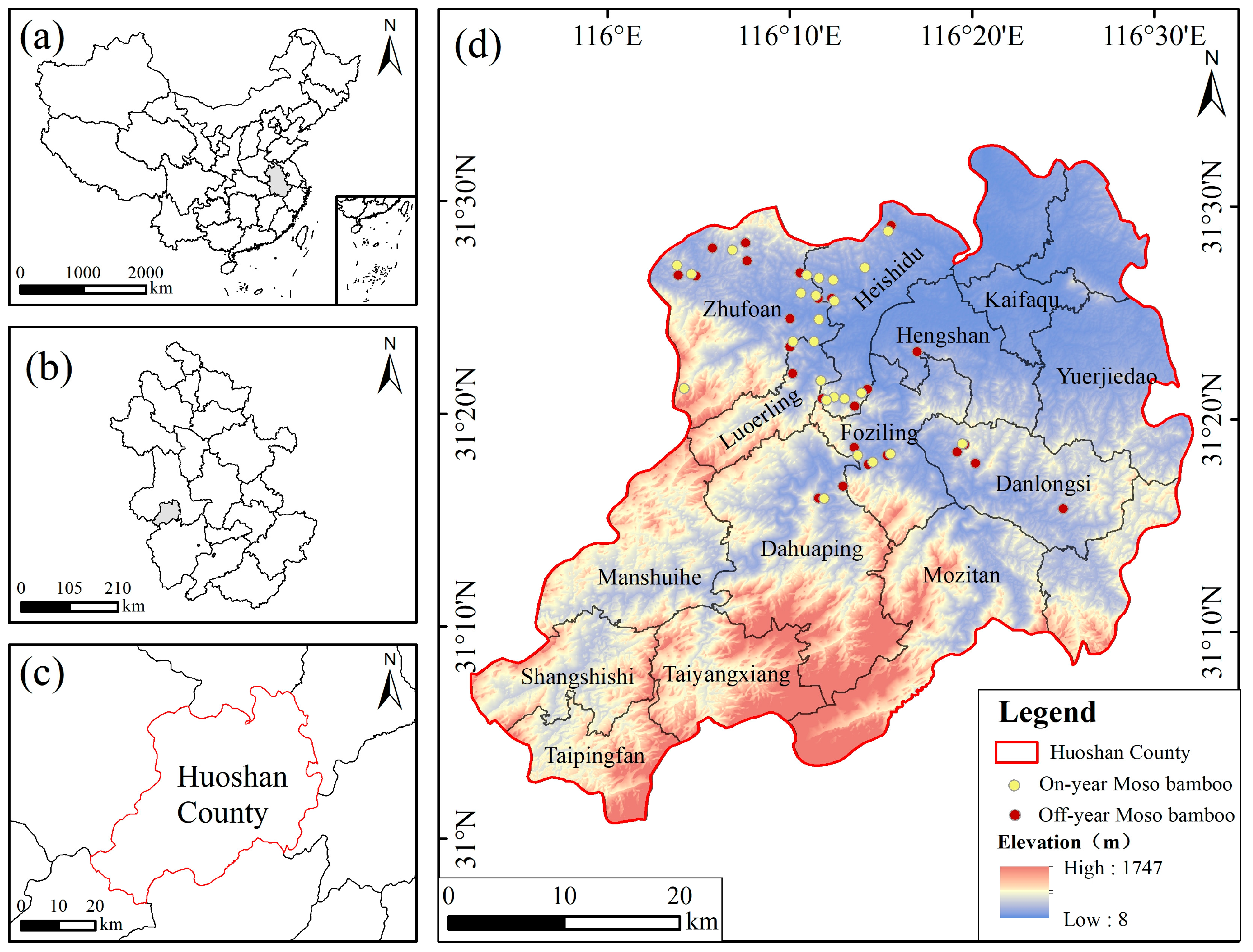
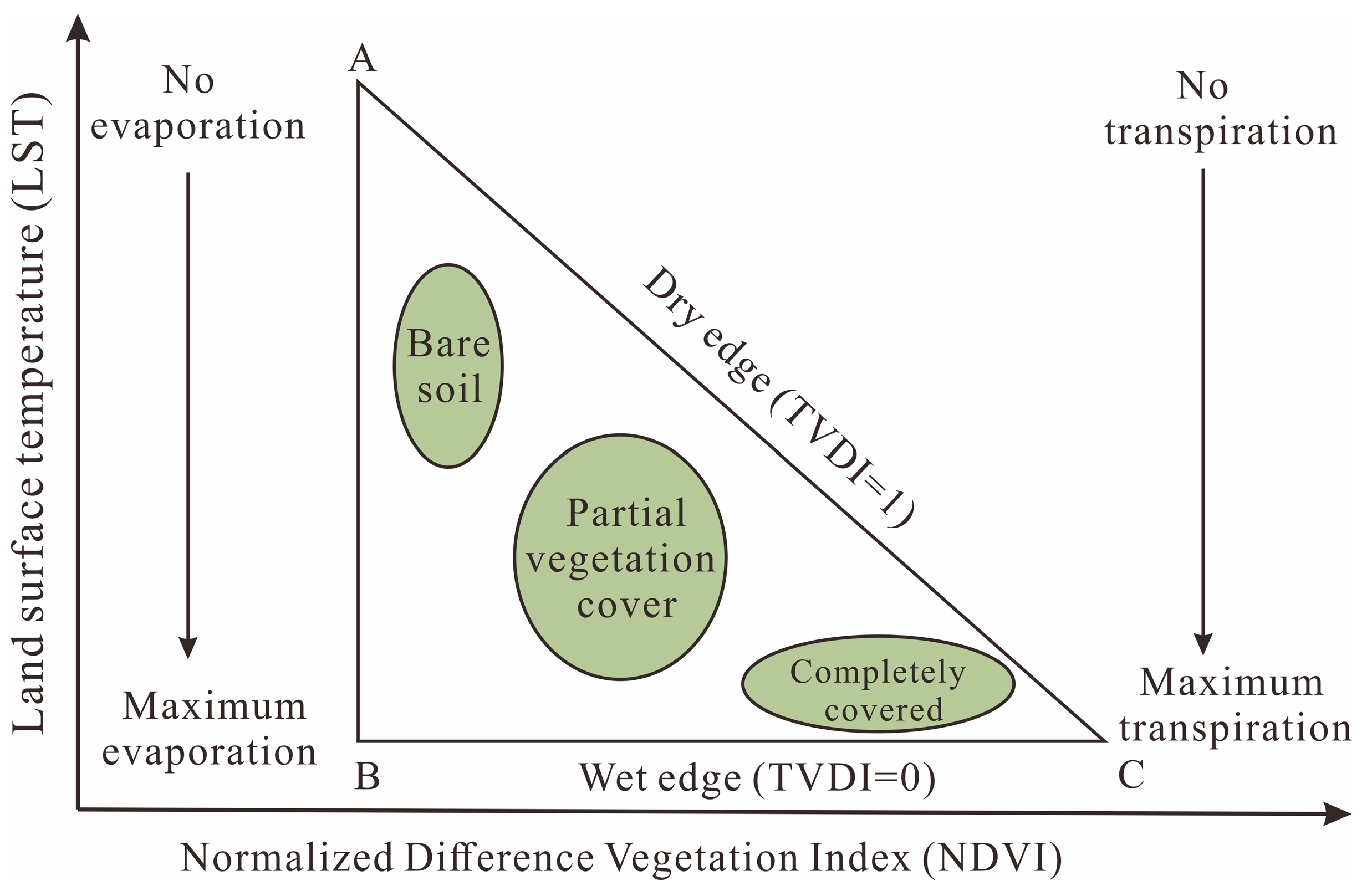
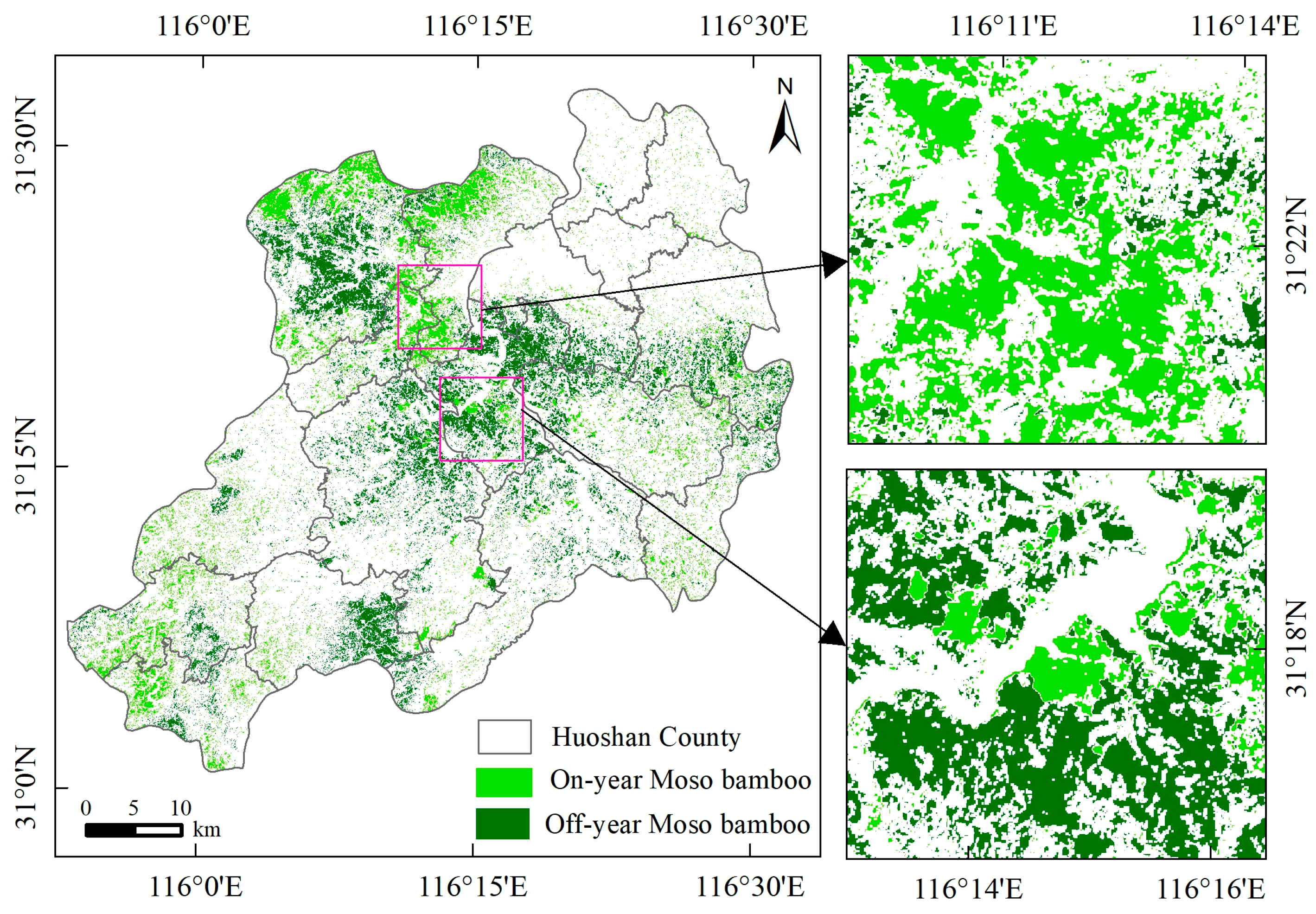
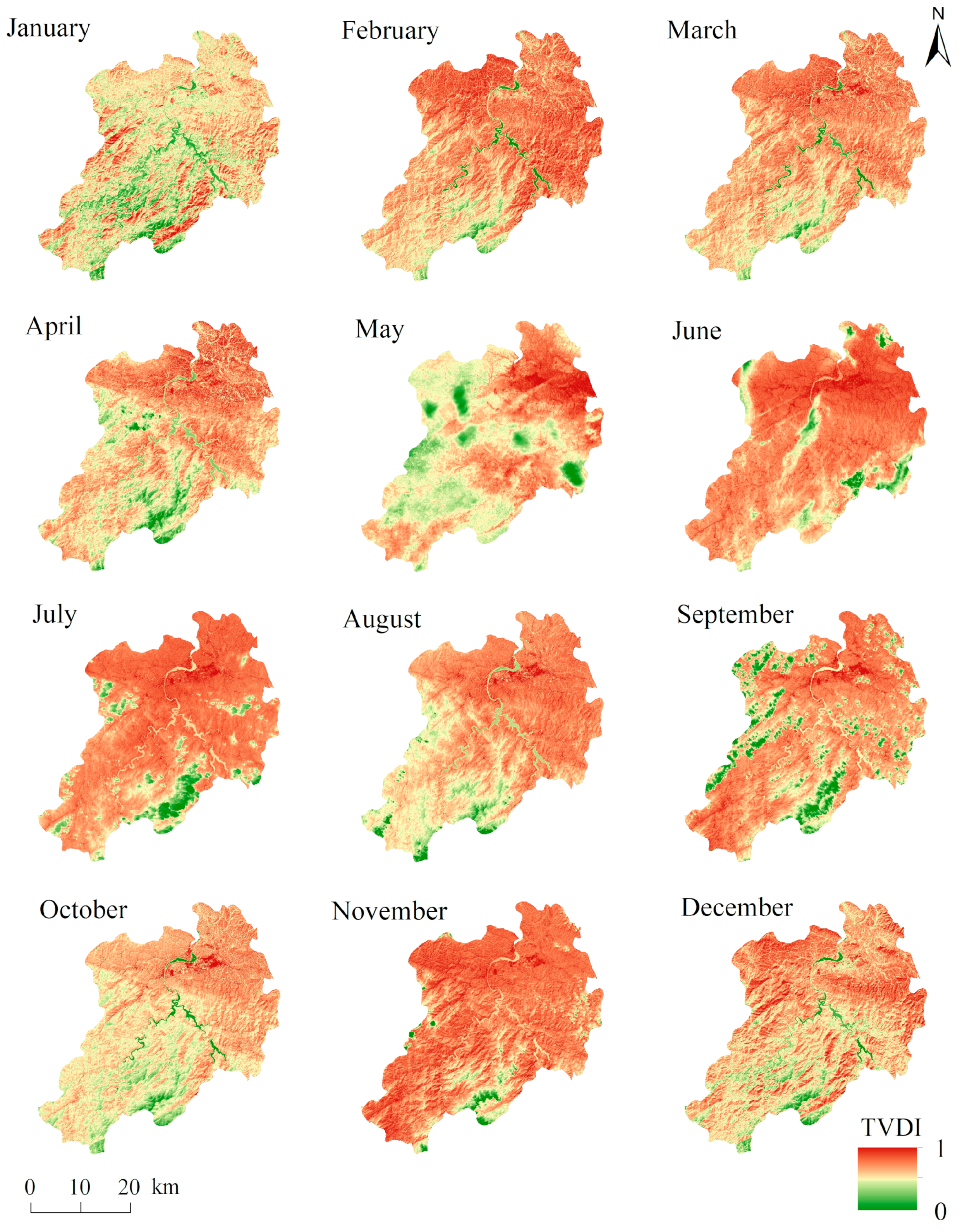
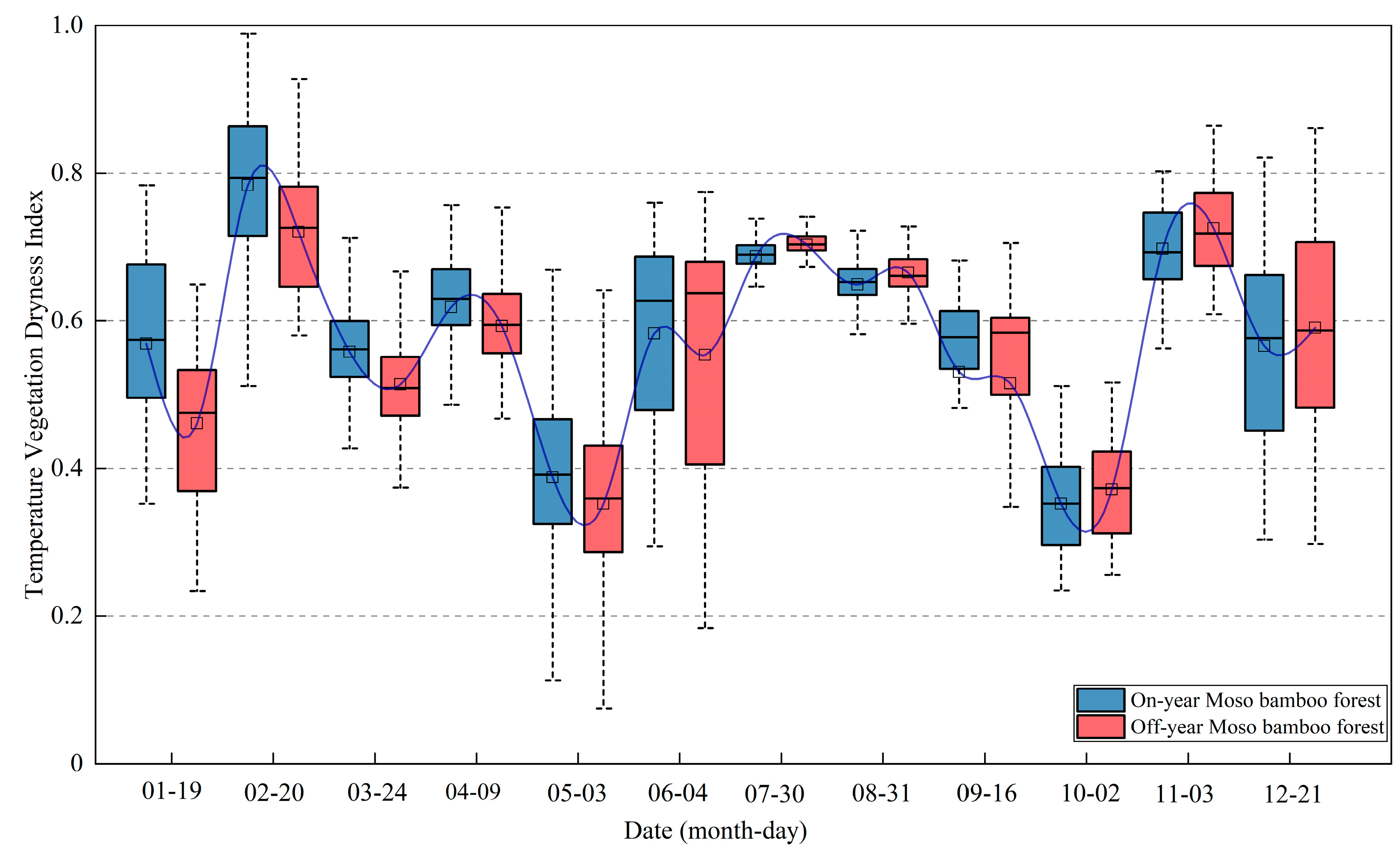

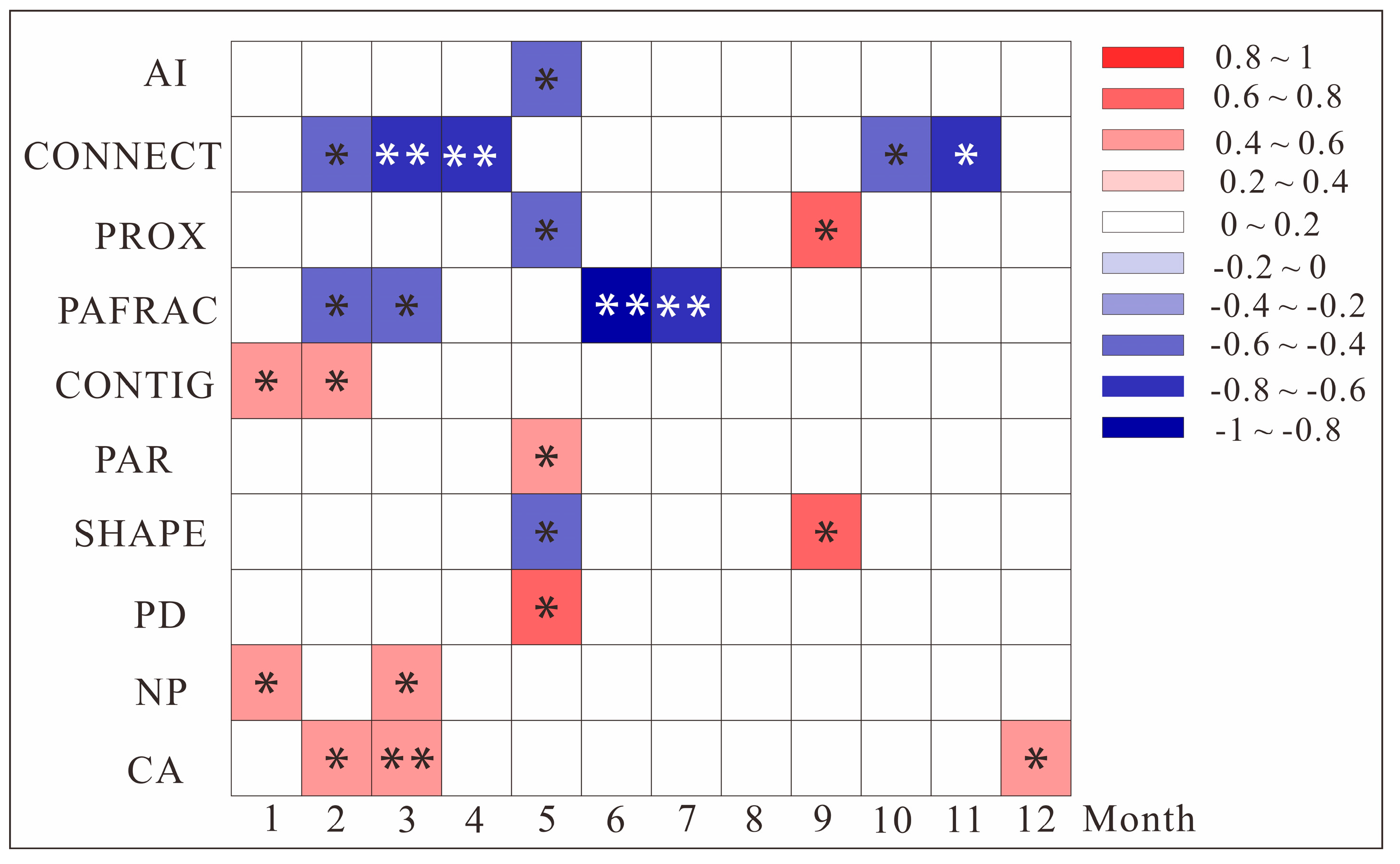
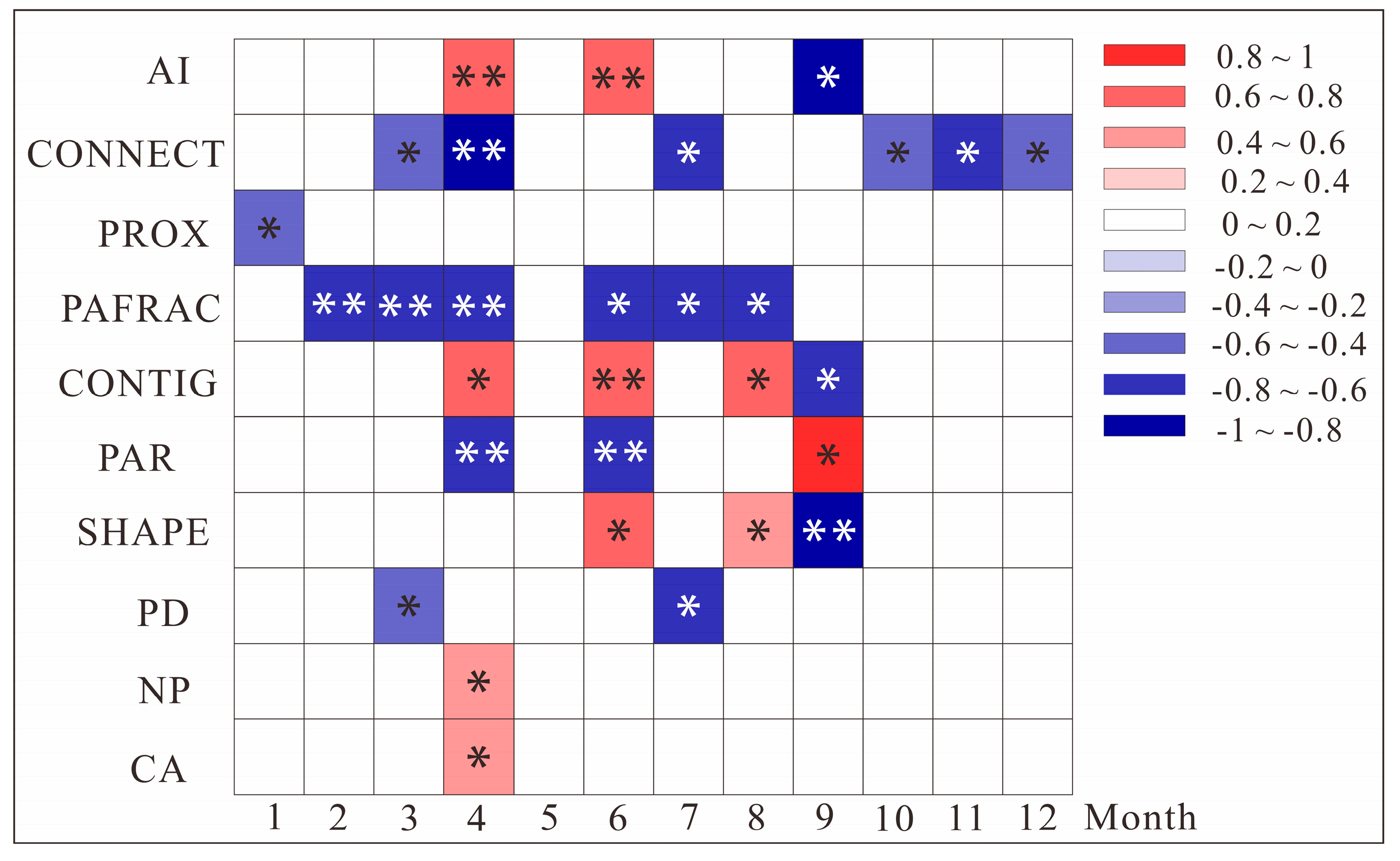
| Dataset | Acquisition Date | Strip Number | Cloud Volume |
|---|---|---|---|
| Sentinel-2B | 18/02/2021, 09/05/2021, 04/05/2022 | 32/50RLV, 50RMV | <5% |
| Landsat-7 | 03/05/2021, 04/06/2021 | 122/38 | <15% |
| Landsat-8 | 19/01/2021, 20/02/2021, 24/03/2021, 09/04/2021, 30/07/2021, 31/08/2021, 16/09/2021, 02/10/2021, 21/11/2021, 21/12/2021 | 122/38 | <15% |
| Landscape Metrics | Unit | Abbreviation |
|---|---|---|
| Class area | ha | CA |
| Number of patches | number | NP |
| patch density | number/100 ha | PD |
| Shape index | none | SHAPE |
| Perimeter-area ratio | none | PAR |
| Contiguity index | none | CONTIG |
| Perimeter area fractal dimension index | none | PAFRAC |
| Proximity index | none | PROX |
| Connectance index | percent | CONNECT |
| Aggregation index | percent | AI |
| Types of Moso Bamboo Forests | Producer’s Accuracy (%) | User’s Accuracy (%) | Overall Accuracy (%) | Kappa Coefficient |
|---|---|---|---|---|
| On-year Moso bamboo forests | 91 | 89 | 88 | 0.81 |
| Off-year Moso bamboo forests | 89 | 92 |
| Date | Dry Edges | Wet Edges | ||
|---|---|---|---|---|
| Regression Equations | Coefficient of Determination (R2) | Regression Equations | Coefficient of Determination (R2) | |
| 19/01/2021 | Dy = 20.6 − 5.33x | 0.62 | Wy = 4.57 − 1.92x | 0.34 |
| 20/02/2021 | Dy = 32.1 − 11.4x | 0.64 | Wy = 13.3 − 5.86x | 0.42 |
| 24/03/2021 | Dy = 41.3 − 13.7x | 0.66 | Wy = 19.9 − 5.06x | 0.43 |
| 09/04/2021 | Dy = 34.5 − 13.1x | 0.77 | Wy = 5.91 + 6.84x | 0.55 |
| 03/05/2021 | Dy = 35.3 − 11.2x | 0.53 | Wy = −65.9 + 96.8x | 0.86 |
| 04/06/2021 | Dy = 49.6 − 16.5x | 0.61 | Wy = −24.9 + 30.1x | 0.21 |
| 30/07/2021 | Dy = 53.7 − 19.3x | 0.74 | Wy = −0.9 + 16.9x | 0.76 |
| 31/08/2021 | Dy = 59.9 − 20.1x | 0.63 | Wy = 13.2 + 7.5x | 0.57 |
| 16/09/2021 | Dy = 46.4 − 14.6x | 0.64 | Wy = 11.0 + 3.86x | 0.68 |
| 02/10/2021 | Dy = 47.4 − 12.8x | 0.64 | Wy = 26.1 − 5.65x | 0.58 |
| 03/11/2021 | Dy = 30.4 − 10.3x | 0.87 | Wy = 2.13 + 7.31x | 0.72 |
| 21/12/2021 | Dy = 22.6 − 5.56x | 0.60 | Wy = 8.73 − 5.07x | 0.63 |
Disclaimer/Publisher’s Note: The statements, opinions and data contained in all publications are solely those of the individual author(s) and contributor(s) and not of MDPI and/or the editor(s). MDPI and/or the editor(s) disclaim responsibility for any injury to people or property resulting from any ideas, methods, instructions or products referred to in the content. |
© 2025 by the authors. Licensee MDPI, Basel, Switzerland. This article is an open access article distributed under the terms and conditions of the Creative Commons Attribution (CC BY) license (https://creativecommons.org/licenses/by/4.0/).
Share and Cite
Zhang, W.; Zhang, J.; Sun, T.; Li, L.; Li, N.; Jiang, L. New Landscape-Perspective Exploration of the Effects of Moso Bamboo On-Year and Off-Year Phenomena on Soil Moisture. Forests 2025, 16, 333. https://doi.org/10.3390/f16020333
Zhang W, Zhang J, Sun T, Li L, Li N, Jiang L. New Landscape-Perspective Exploration of the Effects of Moso Bamboo On-Year and Off-Year Phenomena on Soil Moisture. Forests. 2025; 16(2):333. https://doi.org/10.3390/f16020333
Chicago/Turabian StyleZhang, Wei, Jinglin Zhang, Tao Sun, Longwei Li, Nan Li, and Lang Jiang. 2025. "New Landscape-Perspective Exploration of the Effects of Moso Bamboo On-Year and Off-Year Phenomena on Soil Moisture" Forests 16, no. 2: 333. https://doi.org/10.3390/f16020333
APA StyleZhang, W., Zhang, J., Sun, T., Li, L., Li, N., & Jiang, L. (2025). New Landscape-Perspective Exploration of the Effects of Moso Bamboo On-Year and Off-Year Phenomena on Soil Moisture. Forests, 16(2), 333. https://doi.org/10.3390/f16020333







